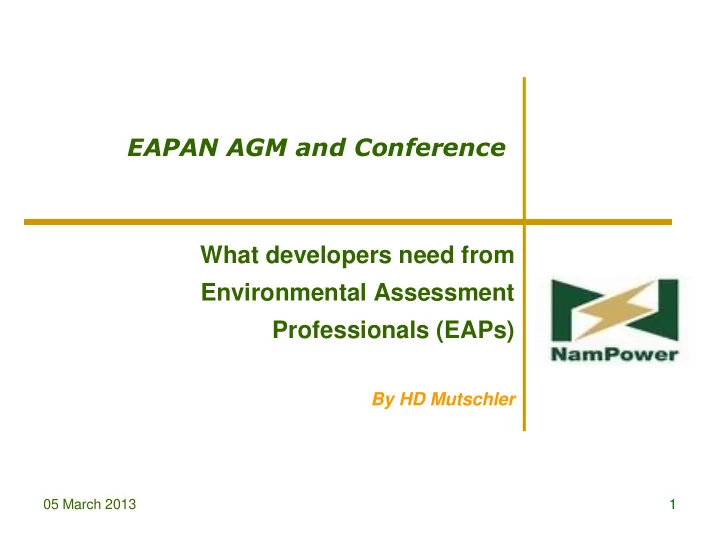

EAPAN AGM and Conference What developers need from Environmental Assessment Professionals (EAPs) By HD Mutschler 05 March 2013 1
NamPower Activities Power System Development Projects Power Stations Transmission Lines Substations 05 March 2013 NamPower 2
EAPs contribution and involvement During the feasibility phase through the execution of the EIA During the design phase through the incorporation of design criteria During the construction phase through the implementation of a construction EMP During the operation phase through the implementation of an operation EMP 05 March 2013 NamPower 3
Conflicting Messages Drive for Development vs Conservation of Environment Energy White Paper, Vision 2030 and NDPs contain ambitious objectives for the Namibian energy sector and acknowledge the vital role played by energy in the country’s economy and national development but with resulting increased wildlife / infrastructure conflict. Availability of Funds vs Cost of Mitigation vs Affordability of Electricity and Infrastructure 05 March 2013 NamPower 4
Legislation and other Requirements EAPs should have a thorough understanding of the legislative environment and requirements for a specific project, beyond just that of the Environmental Management Act. Labour Act Draft Compensation Policy Guidelines for Communal Land IFC Resettlement Handbook NamPower Procurement Policy 05 March 2013 NamPower 5
Thorough understanding of project and basic technical knowledge Impractical conclusions and recommendations in EIA reports are made just as a result of a lack of technical understanding of the project. As a minimum the project co-ordinator or report compiler should have some knowledge of the technical aspects. It is expected that EAPs conduct quality research on the issues at hand, as it is related to the project, beyond that of “ google engineering”. 05 March 2013 NamPower 6
Thorough understanding of project and basic technical knowledge 2 NamPower Network Types of Structures (small stick drawing, voltage and typical conductors/GW/OPGW) Design criteria (voltage/power transfer, type of structure, line route, budget, cost of bends) Option Form for Wayleaves Servitudes (drawing of servitude widths) Safe clearances (Operating Regulations) Route clearing and gates (Policy) 05 March 2013 NamPower 7
Mitigating measures Recommended mitigating measures should be: P ractical, I mplementable and A ffordable It should not create knock-on impacts and consequences more serious than the impact mitigated It should take cognisance of scale of implementation, cost, trade-offs with other impacts, impact on efficiency of operation, minimum statutory requirements, Recommendations should be considered a good balance between the cost of mitigation and the cost of the development. 05 March 2013 NamPower 8
Conflicting Specialist Requirements When trade-offs are experienced, the EAP team should recommend the “lesser” evil clearly Height of stack to allow emission dispersion vs visual impact of higher stack Grouping of services like roads, power lines vs visual impact of lines Routing of Power lines: Archaeology vs Flora Rehabilitation vs monitoring after construction 05 March 2013 NamPower 9
Reports and recommendations EAPs should delivery qualitative reports and recommendations Accurate in facts, consistently in using assumptions throughout and across specialist reports, properly referenced, factual and without speculation or personal biased opinions Recommendations must be based on facts and not on perceptions Data and information used should be current and not outdated 05 March 2013 NamPower 10
Differences between EAPs EAPs should work cohesively as a professional team and differences between specialists in a field or across fields should be clearly addressed and put into context Developers confused by territorial battles and difference in findings on same issue Proper co-ordination between specialists and consistent requirements from various environmentalists EAPs should be professional and personal opinions should be avoided Findings and recommendations must be debated and discussed between the affected parties. 05 March 2013 NamPower 11
Public Participation Process EAPs should implement a public participation process that is effective and efficient The traditional ways of PPP is a waste of time, effort and cost Lack of Participation by I&Aps 05 March 2013 NamPower 12
Information from previous projects When material, models, information from a previous project is used, it should be reflected in the pricing of the EIA study Developers should benefit from using previous work executed on their own projects or other developer’s projects 05 March 2013 NamPower 13
Sustainable Development EAPs should assist developers in meeting all three objectives of sustainable development EAP’s should be an independent voice, recommending best balance between developer’s requirements, society’s needs and long term environmental impact Yet, the only long term solution lies in strong co-operation between developers and EAP’s towards common goals 05 March 2013 NamPower 14
Thank you 05 March 2013 NamPower 15
List of Documents on CD NamPower Procurement Policy EIA – Scope of Services NamPower General EMP Presentation 05 March 2013 NamPower 16
Feasibility phase The occurrence of settlements and homesteads, and safe clearances from these; Aesthetic impacts; Airfields; Land use conflicts; (including existing EPLs for Mining Rights, etc) Sensitive environmental areas; Flood-lines; Access to the site. 05 March 2013 NamPower 17
Design phase Requirements of the EMP will be incorporated in the design of the project Deviations will be discussed and agreed upon 05 March 2013 NamPower 18
Construction phase Implementation of requirements of EMP will be implemented and monitored Adherence to EMP will be audited and signed off on completion of the project 05 March 2013 NamPower 19
Operation phase Monitoring of infrastructure - wild life conflict and reporting Monitoring of effectiveness of mitigation measures applied Monitoring of re-growth and application of herbisides Maintenance of servitude 05 March 2013 NamPower 20
Recommend
More recommend